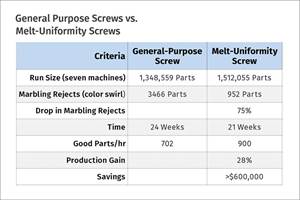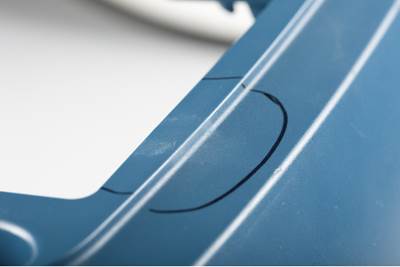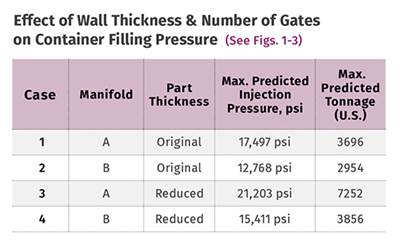When Injection Molding Simulation Can Be a Great Troubleshooting Tool
Injection molding simulation can serve as a powerful tool not just for design but also for ongoing production optimization.
As plastic product designs become more intricate and customer demands continue to rise, the challenges for designers and manufacturers grow significantly. Parts are being designed with thinner walls, and more complex features are being integrated into compact assemblies, pushing the limits of traditional plastic part design. These advancements often lead designers to break established design rules, creating new risks and complexities. In response, molders and toolmakers are tasked with finding innovative solutions to address these challenges while preserving the original design intent.
Injection molding simulation tools, such as Autodesk Moldflow, have become essential for identifying potential risks early in the design process, enabling designers and OEMs to explore effective solutions to mitigate these risks. While simulation is traditionally viewed as an upfront tool used during the design phase, its value extends well beyond that. In fact, injection molding simulation can be an invaluable troubleshooting resource during initial mold qualification and for addressing persistent manufacturing issues. This article will explore how injection molding simulation can serve as a powerful tool not just for design but also for ongoing production optimization.
Considerable time and effort are invested on a given design to ensure it will be able to perform its intended function. This includes selecting the right material for the application, designing robust attachment and stiffening features, and ensuring ease of assembly. However, once the design has been finalized and turned over to the manufacturing partner, the timeline is often compressed and leaves little margin for error. When issues arise during the mold qualification process, a solution needs to be identified quickly.
Injection molding simulation creates an opportunity to build a digital twin of the mold and process, enabling stakeholders to get a peek inside the tool.
Oftentimes, a molder will resort to developing a physical design of experiments (DOE) where many different populations are generated that vary the conditions under which the parts are made. These populations will then need to be tested or measured, which leads to long delays and significant additional costs to try and find a solution. Moreover, many times the molder has limited data it can collect and utilize to find an end solution. Injection molding simulation creates an opportunity to build a digital twin of the mold and process, and enables the stakeholders to get a peek inside the mold and gather significantly more data to help them identify potential root causes and make decisions.
Simulation Extends Investigations Beyond Process Variables Into Geometric Variables
While a physical molding trial can investigate process variables related to the molding operation, it cannot easily account for geometric features within the part or mold design. As stated previously, while an issue may be identified during the manufacturing of the component, manufacturing may not be the root cause of the rejected parts. Rather, the issue may be related to a misalignment between the mold and part design. Many of the injection molding simulation packages available today enable not only the process variables to be investigated but can efficiently examine how modifications to things like rib or part wall thicknesses, gate size or even gate location can affect the part quality (Figure 1). All these changes can be performed in CAD, which helps minimize costs and reduces the time to quantify the potential benefit.
FIG1 — Injection molding simulation can expand the variables of a DOE to geometric features, like rib thickness, to see how the part quality might be influenced. Source (all images): The Madison Group
Simulation Can Generate More Data Points by Looking Inside the Mold
In addition to increasing the scope of an investigation, injection molding simulation enables the analyst and designer to gain insight into what is happening to the plastic material as it flows into the mold. The simulation creates thousands to hundreds of thousands of nodes that essentially act as virtual in-mold sensors, recording data about the temperature and pressure history through the mold-filling-and-packing stages.
FIG 2 — Injection molding simulation enables monitoring of the plastic conditions of the molten polymer throughout the entire cavity, which provides more information for troubleshooting problems. Images above show the temperature (Left image) and pressure (Right image) throughout the entire cavity at a specific time in the molding cycle.
Therefore, we are not limited to a few select points where a pressure or temperature may be measured in a mold by a sensor, or the values at the injection unit. Rather, we can quickly investigate the distributions within the cavity, and how the conditions may change based on either time or distance from the gate. This can be invaluable data for troubleshooting cosmetic issues such as splay, flow lines or sink formation.
Simulation Can Break Down the Causes of Part Warpage
The benefits for simulation have been well documented for optimizing the mold-filling parameters of a given component and mold design. However, as the technology has evolved and the material data fidelity has improved, simulation increases its utility in helping better identify the driving factors for part warpage. Injection molding is attractive because of its ability to produce dimensionally stable parts. However, warpage is reliant on numerous variables and their interaction with one another. When performing a physical DOE, it can be difficult to capture the influence of all the variables, like mold temperature, plastic temperature and volumetric shrinkage distribution. However, simulation enables all these variables to be investigated, and can help isolate the driving variable(s) that are causing warpage (Figure 3). Finally, by performing injection molding simulation as a part of the troubleshooting process, a molder or toolmaker could significantly reduce the scope of the variables they may look at in a physical DOE, again saving time and money.
FIG 3 — Injection molding simulation can help isolate the causes of warpage, and help molders minimize the number of variables they may investigate during a physical DOE.
Setting Yourself Up to Successfully Use Simulation for Troubleshooting
While the promises of injection molding simulation can be realized, it is important that the proper information is provided so the system is as complete as possible. To obtain the greatest benefit, it is important that the feed system and cooling line layout be incorporated into the simulation model. Additionally, it is important that the actual plastic processing conditions — such as melt temperature, coolant inlet temperatures and flow rates — be captured to best represent the thermal history of the material through the molding cycle.
Simulations create thousands of nodes that act as virtual in-mold sensors, recording data about temperature and pressure history through mold filling and packing.
Additionally, it is important that the actual mold-filling time and packing-pressure profiles be captured to ensure the pressure history is properly captured in the simulations. We should not blindly use machine parameters as surrogates for our simulation parameters. Doing so could lead to inaccurate conclusions that may lead our team down the incorrect path. Finally, it is important that the plastic material data used in the simulation is for the exact grade we are using in our application. Simply selecting a resin that has a similar melt flow rate or glass-fiber loading within the same family may not be sufficient to get the processing insight we are looking for. If care is taken to capture these details, then it is possible to create a very good digital twin of our mold that in the end can save us time and money. That isn’t to say that if you don’t have all the systems and parameters for your mold and molding process simulation, it is not a good tool. It is simply stating that the results should be scrutinized a bit harder when picking a path forward.
FIG 4 — It is important to model in as many systems of the mold as possible and get accurate processing and material properties conditions to fully realize the benefits of simulation.
So, the next time you are having trouble with molding good parts, or you have a narrow processing window for making those parts, I encourage you to consider taking a step away from the machine and see if simulation may be the tool that can help get you the data you truly need to keep helping you moving forward.
About the author: Erik Foltz is a certified professional Moldflow consultant at the Madison Group. Foltz received his master’s degree from the Polymer Engineering Center at the University of Wisconsin. His specialties include plastic part design verification, process optimization and troubleshooting for injection and compression molding, as well as plastics failure. Contact: 608-231-1907; erik@madisongroup.com; .
Related Content
Three Key Decisions for an Optimal Ejection System
When determining the best ejection option for a tool, molders must consider the ejector’s surface area, location and style.
Read MoreUse These 7 Parameters to Unravel the Melt Temperature Mystery
Despite its integral role in a stable process and consistent parts, true melt temperature in injection molding can be an enigma. Learning more about these seven parameters may help you solve the puzzle.
Read MoreUsing Data to Pinpoint Cosmetic Defect Causes in Injection Molded Parts
Taking a step back and identifying the root cause of a cosmetic flaw can help molders focus on what corrective actions need to be taken.
Read MoreImprove Production Rates Via Screw Design — Barrier vs. General Purpose vs. Melt Uniformity
I’m looking for a few good molders to help trial a new screw design, and share data and results for a future article to prove the benefits of a melt uniformity screw.
Read MoreRead Next
Get the Most From Fiber-Reinforced Thermoplastic Composites Parts
There are five specific areas that designers and manufacturers need to consider to realize the potential of these unique materials.
Read MoreUsing Data to Pinpoint Cosmetic Defect Causes in Injection Molded Parts
Taking a step back and identifying the root cause of a cosmetic flaw can help molders focus on what corrective actions need to be taken.
Read MoreINJECTION MOLDING: The Importance of Nominal Wall For Lightweighting Molded Parts
Establishing a nominal wall is one of the most important decisions an engineer makes when designing parts. Understanding how design changes will impact the manufacturing process is critical to ensure the part performs as expected.
Read More











